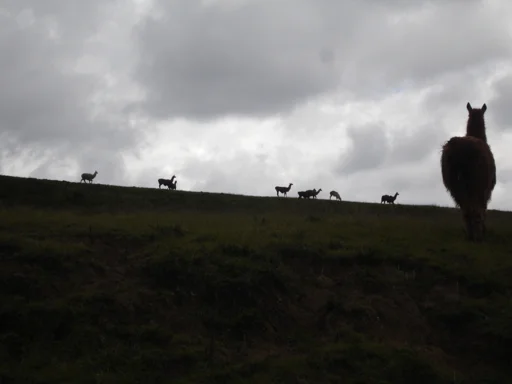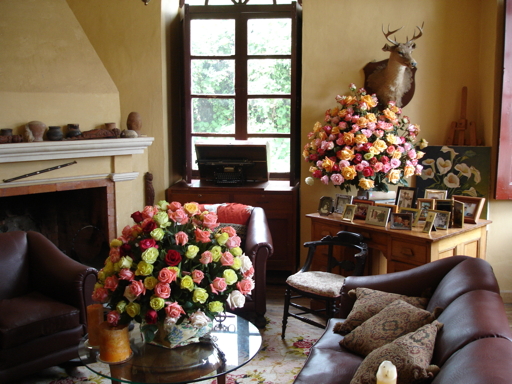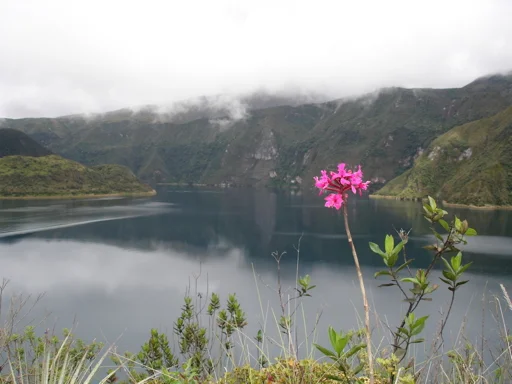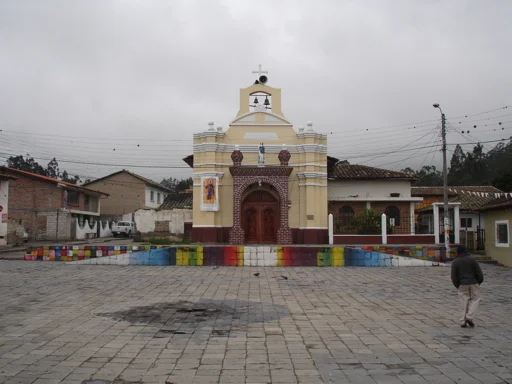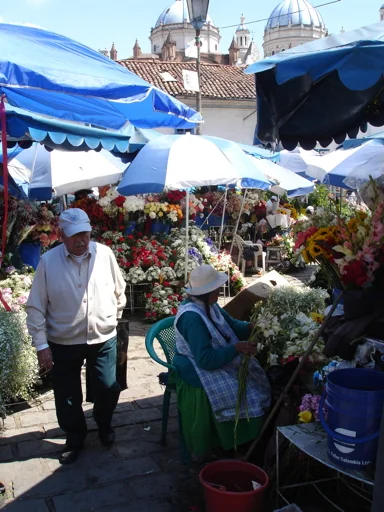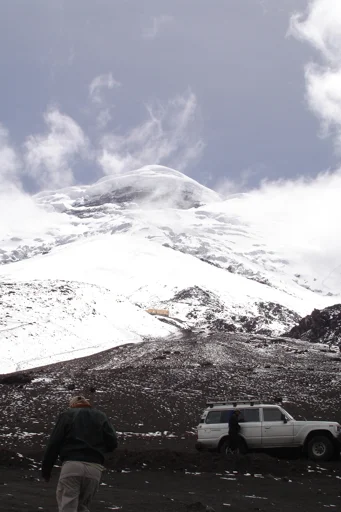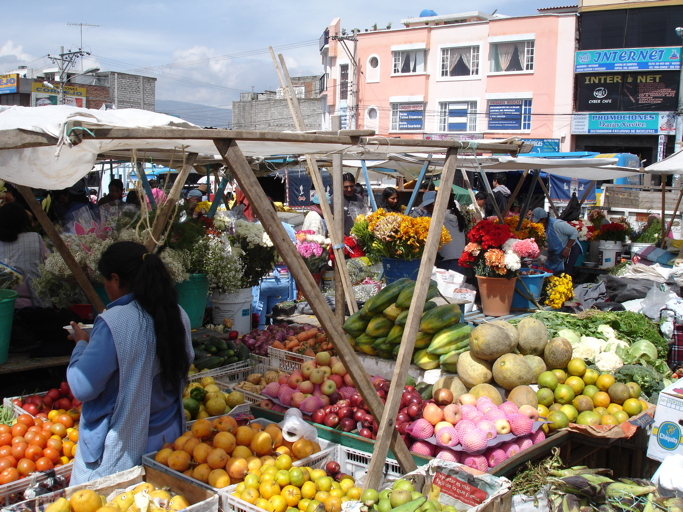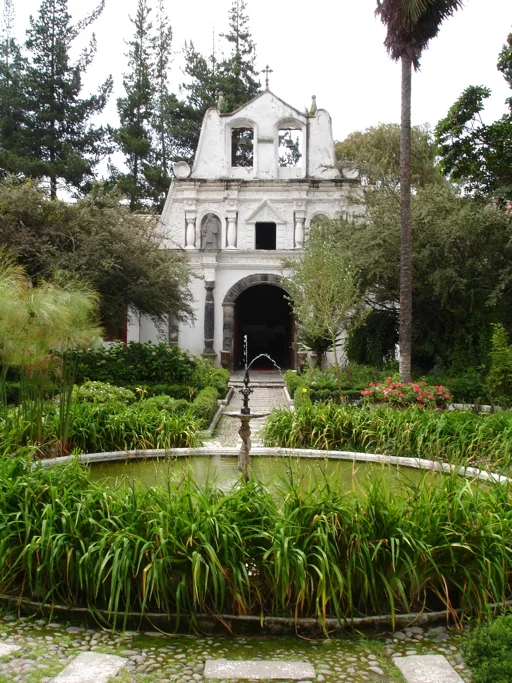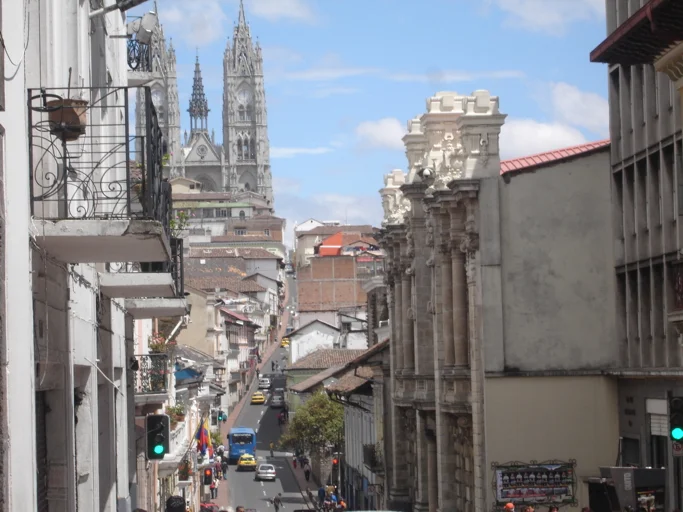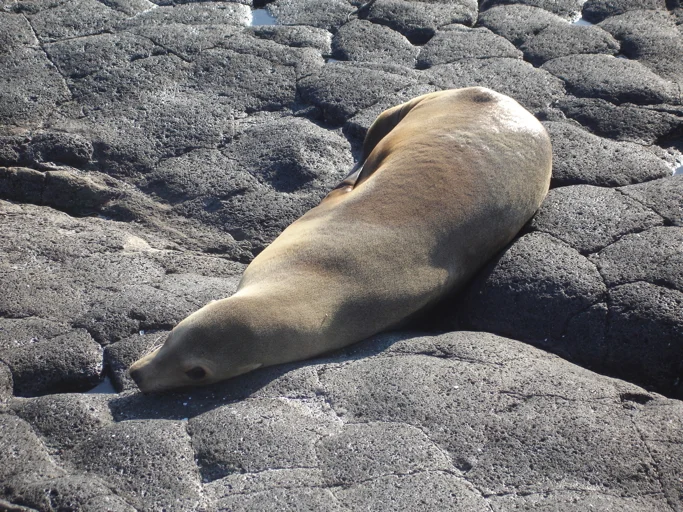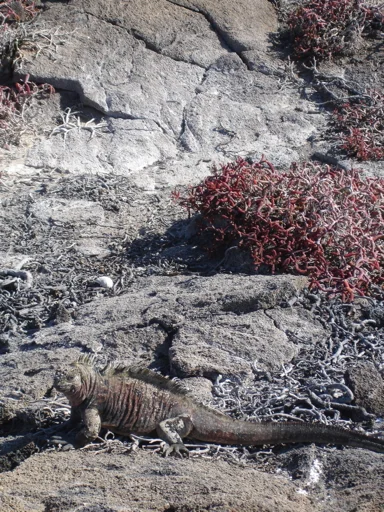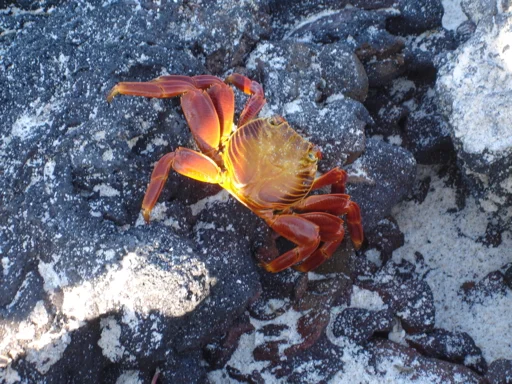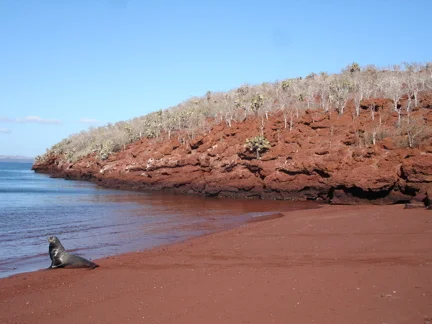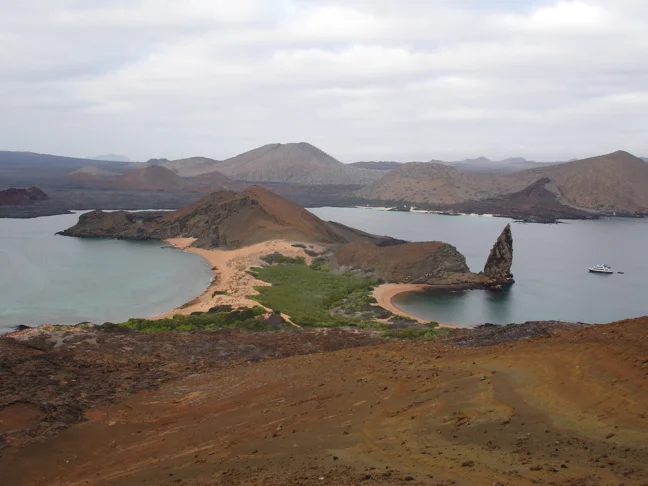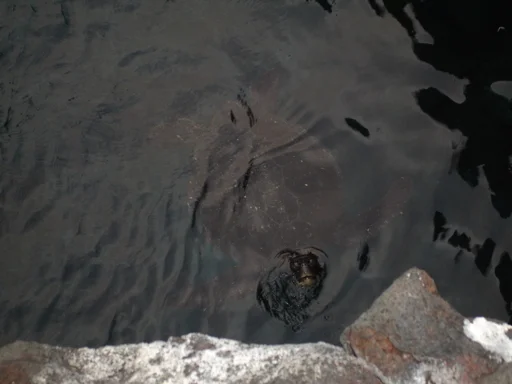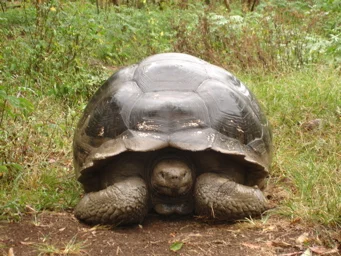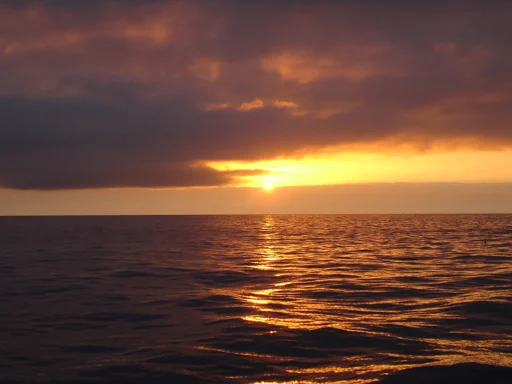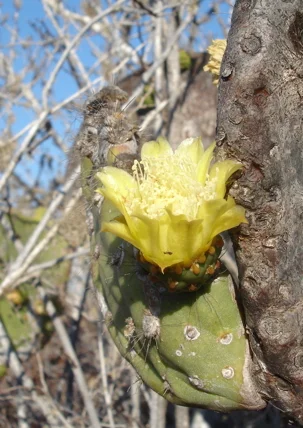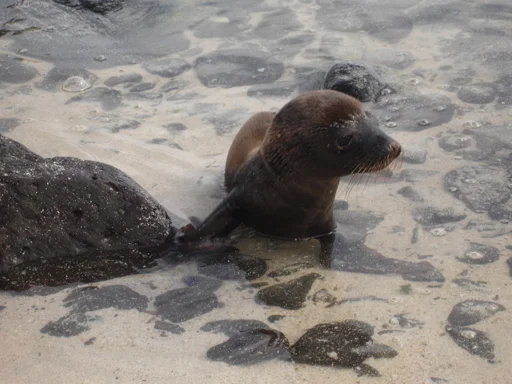...Continued from Part 1
On returning to Quito we checked back into the same hotel as before, and then took a stroll around the two main squares. Every sunday Quito makes the historic city centre a pedestrian zone - which is great, unless you are trying to get to your hotel in the centre of the city with lots of luggage. The evening meal was at a Japanese restaurant - and i have to say that the food was pretty good (considering that your'e eating Japanese food in Ecuador!).
7 January 2008
Having returned to Quito we took a coach journey up to the Andes where we took a hike up in the mountains alongside a mountain stream. Following that we visited lovely private natural springs where i took a relaxing dip in some mineral enriched pools. The sulphur smell was a bit off-putting but the temperature of the water was nearly 30 C!
Also i realised that i’ve never been so high in terms of altitude before. We had driven to nearly 12,000 feet above sea level. The air is noticeably thin. Quito, which is 9,000 feet high, is a dangerous place to drink, as i found out. Your tolerance to alcohol rapidly decreases, and one glass of red wine in Quito has the same effect as half a bottle of red wine in London - however i really love South American red wines, so it can be very hard to resist!
Another remarkable fact that i learnt is that 16% of the world’s bird species are found in Ecuador - and this is a country that only occupies 0.2% of the world’s land surface. In addition, the largest (Condor bird) and smallest (a type of Humming bird) can be found in Ecuador. This country is so much more amazing then i could have ever imagined.
8 January 2008
Today we took a coach ride to ”Otavalo”, where there is a beautiful hacienda called Hacienda Cusin. As I'm writing now, I'm lying in my bed in front of a warming log fire in this lovely and very authentic hacienda. Who would imagine the need for a log fire while sleeping on the equator. It even has a pool table..!
Earlier today we visited a pre-Inca site north of Quito, where there were up to 15 pre-Inca pyramids. The majority of these pyramids were pretty impressive in size. However, since this tribe was aware that the Incas were going to invade these lands, the tribe covered their temples in earth and grass to hide them. Unfortunately only one had been partially excavated.
Following that we visited a farm that grew roses. This place grew over 70 different varieties of rose. Ecuador produces the most perfect roses anywhere in the world. This is due to the volcanic soil and also the fact that the sun passes directly over the lands due to the position on the equator. This causes the roses to have the most perfectly long straight stems.
Never have i been so overwhelmed by roses. These are long stemmed roses roughly the size of a small fist. The sorting plant and the greenhouses (17 in total over 45 acres) were very impressive. It seems like they have got this down to a fine art. The roses here are sold to the middle man for $3 for 25 roses. When the roses are sent (most likely) to Amsterdam they are stored at minus 3 C to preserve them. A fantastic tip i picked up was that if you have cut roses, in order to prolong their life, it is best to change to water every one or two days. Also, you should cut a tiny bit off the tips of the roses at base/end of the stem every time you change the water. This allows for the roses to stay fresh for up to 3 weeks!
9 January 2008
Today was a quiet day, well relative to the other days so far this holiday. Shopping turned out to be the theme for the day...
We started the day by visiting a textiles factory and seeing how some of the Indian designs and fabrics are made. After that demonstration I bought a lovely Alpaca wool jumper, which i’ll be donning in the office sometime soon. Then we drove to a lake which is a volcano crater that has been filled in by rainfall and some natural springs. It is a beautiful setting, and the lake itself it some 600 feet deep, which is quite deep by any standards. On the way to a town called Octavalo we stopped off in a town renowned for its leather. Here I found the most beautiful of brown leather jackets. I put the jacket on and it fit like a glove - it was love at first sight. After much deliberation, i bought the jacket - which cost me $140/£70 - where in London can you find a jacket for that little? Though i must admit, it is hard to find the motivation to buy a leather jacket when the climate is very hot, and even the thought of trying on a leather jacket brings on an immediate sweat.
After this we visited the market town called Octavalo, which has a very large fabrics market selling very cheap textiles. A few rugs and cushion covers later we were on our way to the airport.
I have never had a city so well promoted before, though Cuenca seriously lives up to its reputation as a very beautiful city. Narrow streets, cobbled roads and very old colonial buildings gives Cuenca a very rustic feel. This my impression just from the trip from the airport to the hotel. By the way, the hotel is a fantastic boutique hotel, which is a conversion of an old house with a central courtyard where all the bedrooms look onto this courtyard. Very charming and authentic. Plus i just discovered that i have a hot water bottle in my bed. Sweet.
10 January 2008
Cuenca is certainly one of the most beautiful cities that i have been to. No question. The town is so rich in history and colonial buildings. This explains why the city is a World Heritage Site. The city is lined with cobbled streets, beautiful plazas, 52 churches (each which are unique in style and structure) and so much history.
Today we visited the three main cathedrals (one which actually is no longer a place of worship but an arts and music venue), the Cuenca Modern Art Gallery, a Panama Hat Factory, a bustling raw food market and a Ceramic Factory. We also did a lot of walking around the city, visiting the various plazas and of course a few shops. I am now a proud owner of a Panama hat made from the city where they first originated. Never would i have thought that a Panama hat (of any type of hat to be honest) could cost in excess of $600. And this is in a so-called developing country. Though to be honest the Panama hat does start to feel like silk when it costs this much.
Only when you are shopping in mainland Ecuador do you remember that the functional currency of the country is the American dollar. This means that the Ecuadorean economy shares in the highs and the lows of the yank economy, although given the somewhat hostile relationship between these two countries it does feel like a precarious arrangement.
One thing which i admire greatly is how much the local government promote culture and crafts. We visited a type of mall, where artists are allowed to exhibit and receive support (in exhibiting, finances, etc) and i bought several small paintings for a total of $31, which i know for sure would have cost a fortune in London. Jewelry is very big in one quarter of this city, and some of the pieces were lovely but unfortunately i don’t have anyone to buy jewelry for.
In the afternoon we visited an Inca ruin, which is the only part of the original town of Cuenca that has actually been excavated - the majority of the ruins of the Inca settlement is believed to be underneath the present city. At the end of the day we drove up to the hill where we were able to see the whole of the city.
After a lovely dinner in the hotel (Mansion de Alcazar - which i am a big fan of after only one night stay so far) i find myself finishing the evening watching Seinfeld on a local Ecuadorean television channel.
11 January 2008
A 5.45 am wake up call is never a nice thing, even more so when you are leaving a lovely city like Cuenca. Still there was little i could do as we had a flight to catch.
Having arrived back in Quito at 9 am we started out on the road to Cotopaxi National Park. This is about one and a half hours drive from Quito. This national park focuses around Cotopaxi Volcano, which is the highest active volcano in the world, with the only glacier on the equator. It is quite a sight to behold. However our tour guide kindly informed us that a neighbouring volcano had begun to spit out larva and ash, so perhaps it wasn’t the best of ideas visiting a volcano today?
We drove up as far as possible on four wheels - which was where the snow and ice began and all signs of life ended. It was quite something. Never have i been at such a high altitude. It was cold, obviously, but that gave me the chance to baptise my new leather jacket. There were lots of weary hikers making the journey to the crater at the top.
After that we drove toward the Hacienda San Agustin de Callo, which is built on the site of an Inca palace, and is regarded as one of the two most important archeological Inca sites in Ecuador. Since the 15th Century this has served as an Inca fortress and palace and Augustinian monastery. It was also the temporary home of the French Geodesic Mission, whose scientific work helped change the shape of the planet.
At diner i met a Belgium couple who are retired now. They travel around the world seven months of the year. That is pretty inspiring and admirable, and certainly something that i’d love to do in the not so near future.
I’ve got a hot water bottle and wood fire again tonight in this hacienda - ah it feels like home. Luckily for me i get to wake up at 8 am tomorrow morning. You can tell I'm not that bitter about the early starts...
12 January 2008
Well it is the last day today, and I’m quite sad that the holiday is over and i’ll be back at work in just over 48 hours.
An easy going day where we drove from our hacienda to a local market at the foot of the Cotopaxi. This market is a fruit, vegetable and meat market, with an emphasis on the locals and their needs rather then those of the tourists. Lots of fruit and vegetables. They grow practically everything under the sun here. This is due to the variety of the regions in the country (rainforest for tropical fruits, highlands and lowlands - which means that agriculture has both access to tropical and temperate climates), along with consistent weather due to being on the equator.
After our visit to the market, we stopped for a quick lunch in the hacienda before driving back to Quito. We returned to our loyal hotel in Quito at 3 pm. Packing turned out to be an arduous task, considering all the “stuff” that i had bought along the way.
I’ve really loved this holiday. There has been so much variety in the past two and a bit weeks, from the wildlife at the Galapagos to the beautiful cities on the mainland. There has been swimming with sea creatures, visiting Inca and pre-Inca ruins, fantastic markets, fascinating treks, bustling markets, great food and very hospitable people in these two weeks.

